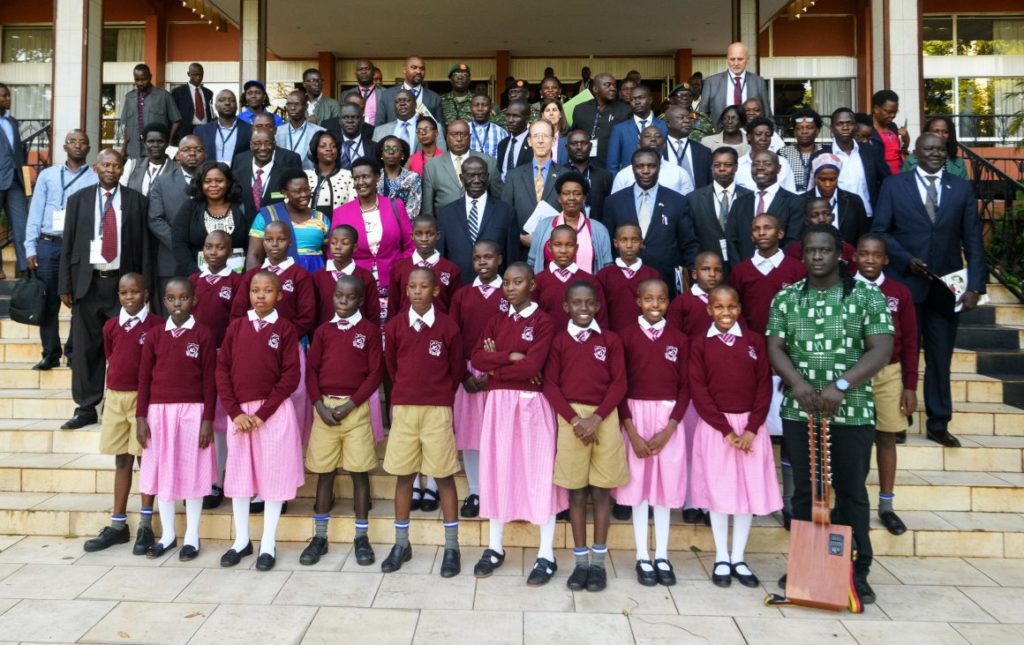
Launch of National Action Plan and Strategy for Aflatoxin Control in Uganda
On the 31st of October, 2018, a National Awareness Campaign for the Control of Mycotoxins with special emphasis on Aflatoxins as launched by H.E Edward Kiwanuka Sekandi the Vice President of Uganda on behalf of H.E Gen. Yoweri Kaguta Museveni the President.
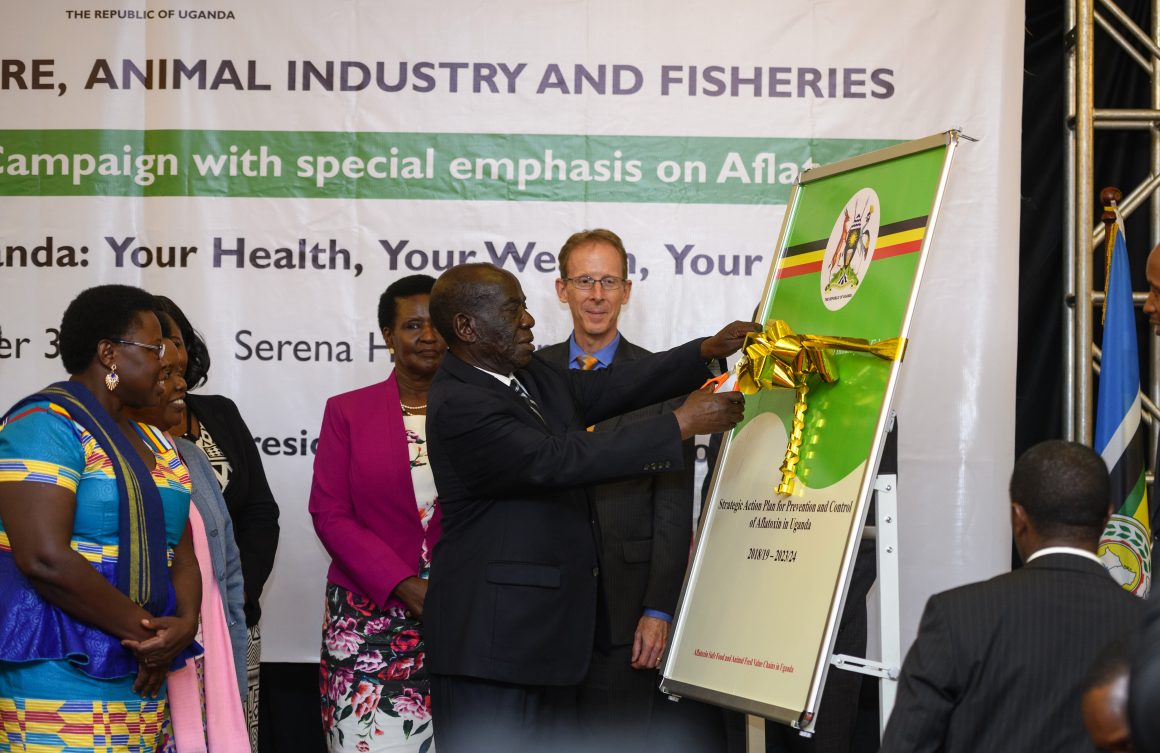
The Campaign included a National Action Plan for Aflatoxin Control along with the related Information, Education and Communication (IEC) materials for creating more awareness about control of aflatoxins.
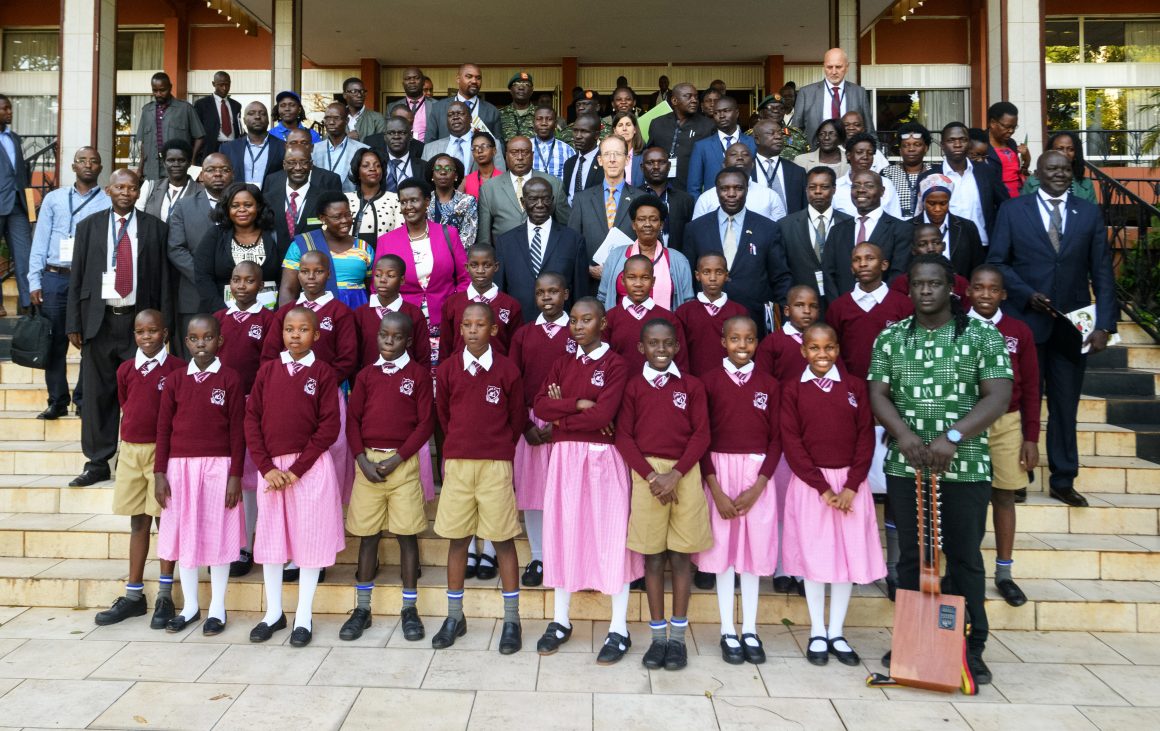
Above: Participants at the official launch of the materials in a group photo with the Chief Guest. The pupils in the front are pupils of Kiswa Primary School in Kampala who presented a theme song and poem with Janzi Band about the fight against aflatoxins during the launch.
These were developed by the Ministry of Agriculture Animal Industry and Fisheries in partnership with the African Union Partnership for Aflatoxin Control in Africa and the USAID Feed the future Uganda Enabling Environment for Agriculture Activity.
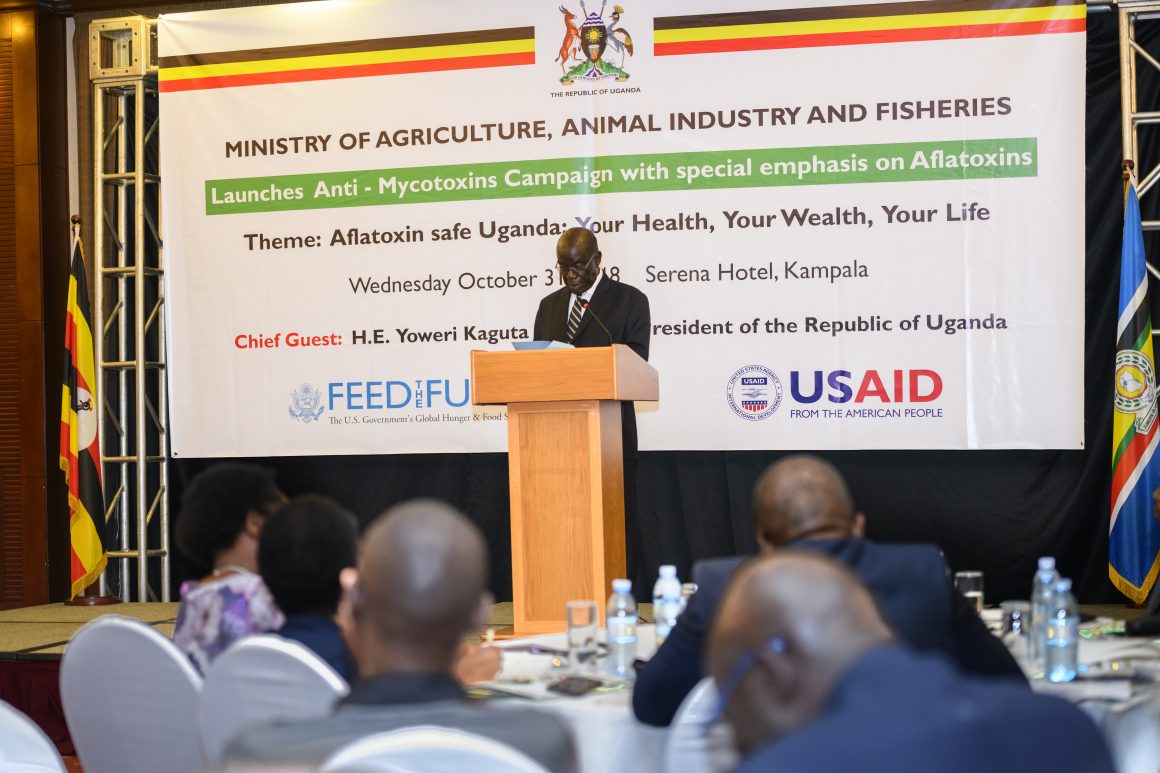
Above: His Excellency Edward Kiwanuka Sekandi delivering the official speech on behalf of His Excellency Yoweri Kaguta Museveni the President during the launch ceremony in Kampala. In this speech the President noted that today, Uganda prides itself of a reduction in poverty levels both in rural and urban settings from 60.2 percent to 29.1 percent in rural areas and 28.8 percent to 9.1 percent in the urban areas. These achievements were between 1992/93 and 2009/10 and that by 2012/2013 Uganda had reduced poverty levels to 19.7%. According to the President, strides made in the fight against poverty enabled the country to achieve Millennium Development Number One of Halving Poverty by the year 2015.

Above: Mr. Pius Wakabi Kasajja the Permanent Secretary of the Ministry of Agriculture, Animal Industry and Fisheries who called upon stakeholders to consider aflatoxin prevalence as a multi-sectoral challenge that requires multi-sectoral solutions.
Steps to be taken by Government and partners after the launch
After the launch, MAAIF will be kicking off countrywide sensitisation in the four geographical regions of the country through the media, extension services and official platforms of the Ministry.
The Ministry will also proceed to present a Cabinet Paper for Cabinet to take a position of aflatoxin control.
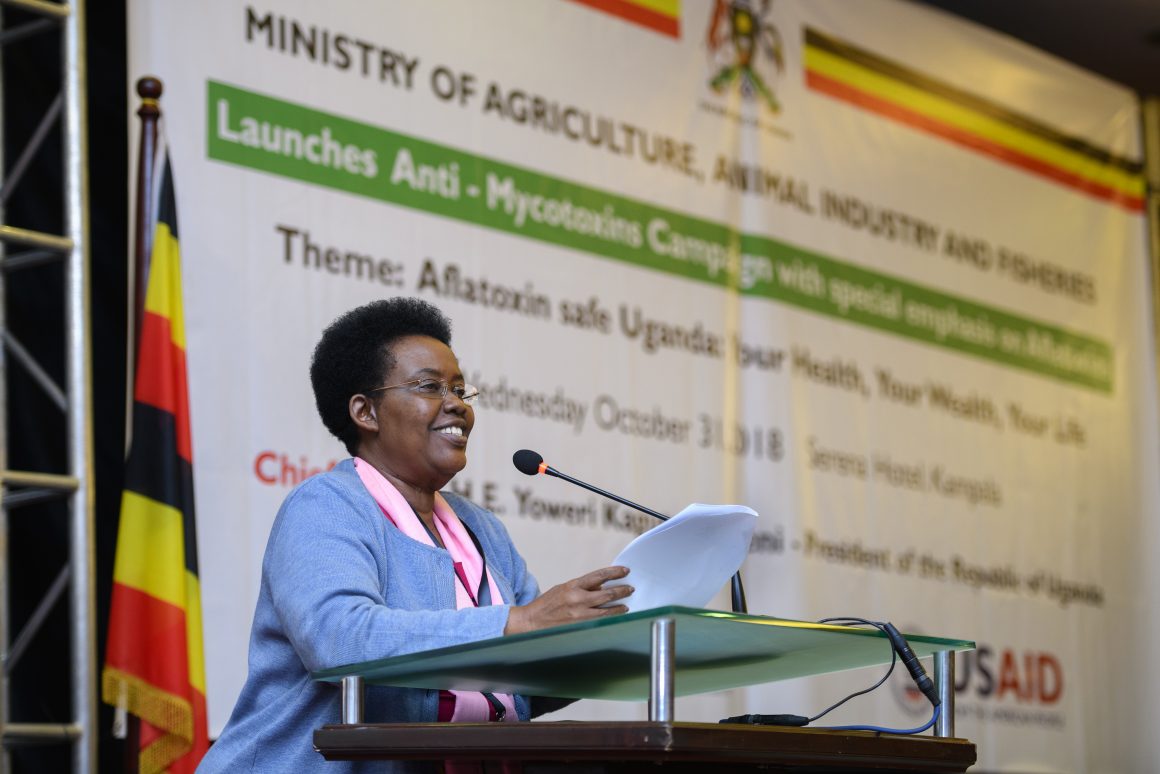
Above: Hon. Joy Kabatsi the State Minister for Animal Industry who highlighted the effect of aflatoxins on the quality of beef and milk from animals that consume the feeds made from the products like maize that are prone to contamination with aflatoxins due to poor handling practices by farmers, processors and traders.
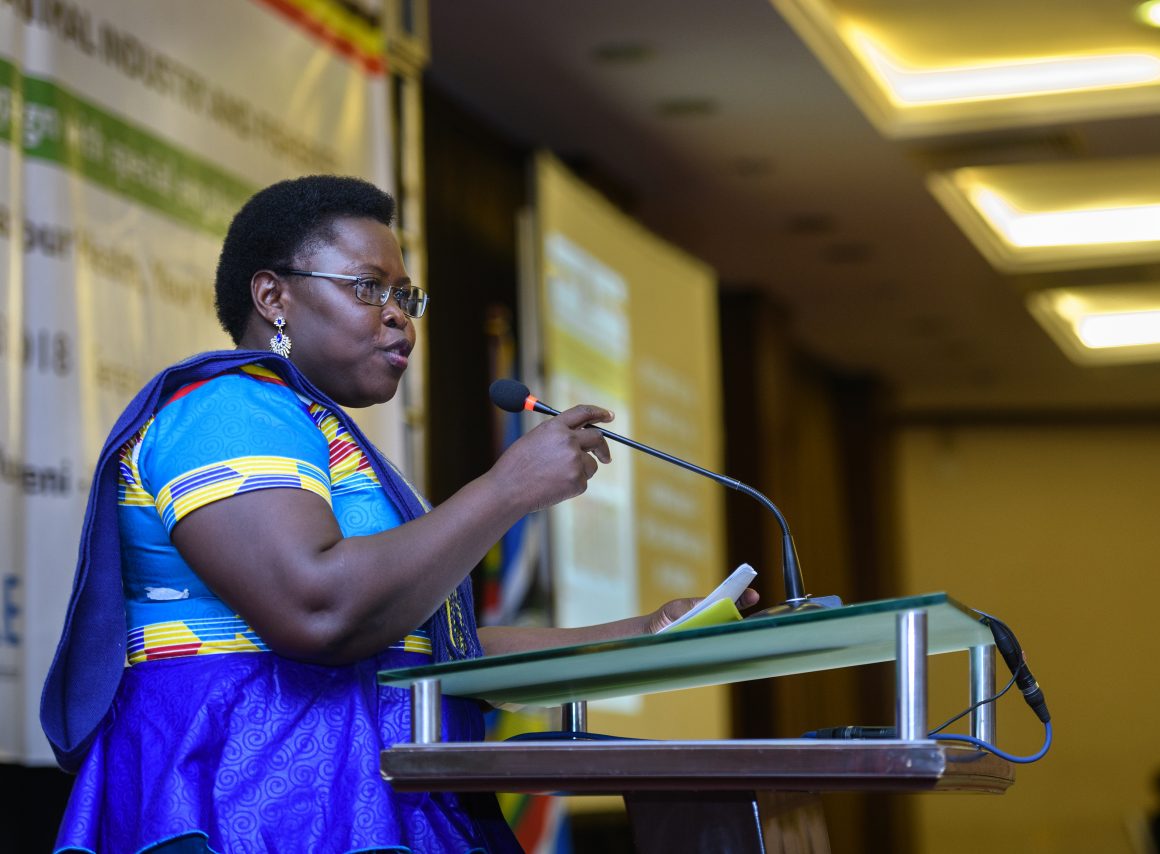
Above: Hon. Dr. Joyce Moriku Kaducu the State Minister for Health – Primary Health Care who highlighted the impact of aflatoxins on human health as toxins which put human beings at higher risk of getting liver cancer.

Above: Prof Archileo Kaaya the Head of the Department of Food Technology and Nutrition in the Makerere University College of Agricultural & Environmental Sciences. In his presentation, Prof. Kaaya informed participants of the standards set for storage of grains. He pointed out the requirement for grains, especially maize to be stored in conditions of 13.5% ,moisture content as recommended by the Uganda National Bureau of Standards (UNBS) and the East African Community.
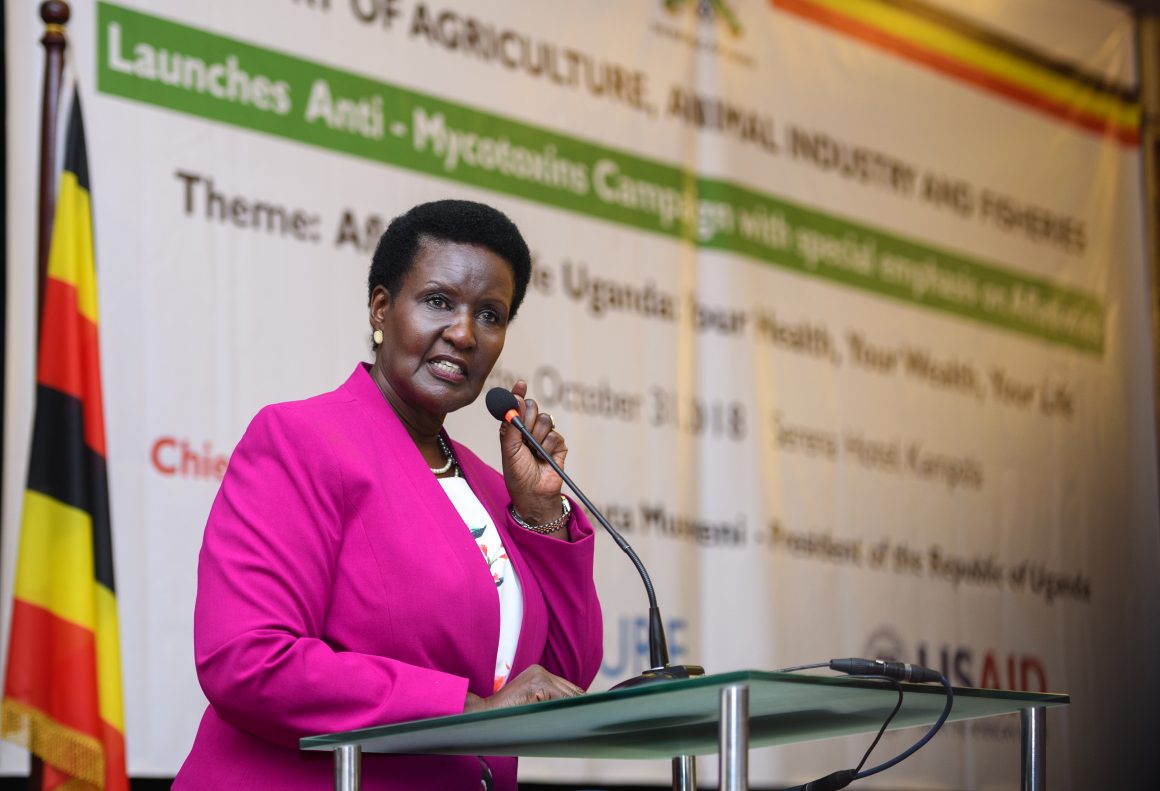
Above: Hon. Amelia Kyambadde the Minister for Trade, Industry and Cooperatives addressing participants at the launch of the Action Plan and Materials. The Trade Minister highlighted the need for traders to join the fight against aflatoxins as a way of avoiding losses that would be incurred by crop, animal and fisheries enterprises. Hon. Kyambaadde also delivered the commitment message on behalf of the Ministry of Trade, Industry and Cooperatives, noting that the fight against aflatoxin prevalence would receive input from the Ministry.
Major partners in the anti-mycotoxins Campaign
The campaign partners include the Ministry of Agriculture, Animal Industry and Fisheries, the Ministry of Trade, Industry and Cooperatives, Ministry of Health, the Ministry of Science, Technology and Innovations, USAID Feed the Future Uganda Enabling Environment for Agriculture Activity and the African Union Commission Partnership for Aflatoxin Control in Africa (AUC-PACA).
Uganda as a leading country in research and control of Aflatoxins: Collaboration with the African Union Commission
Over time, Uganda has received technical support from regional and global partners in this endeavour of controlling aflatoxins.
In the year 2014, Uganda was selected as one of the first five pilot countries of the Partnership for Aflatoxin Control in Africa under the arrangement of the African Union Commission.
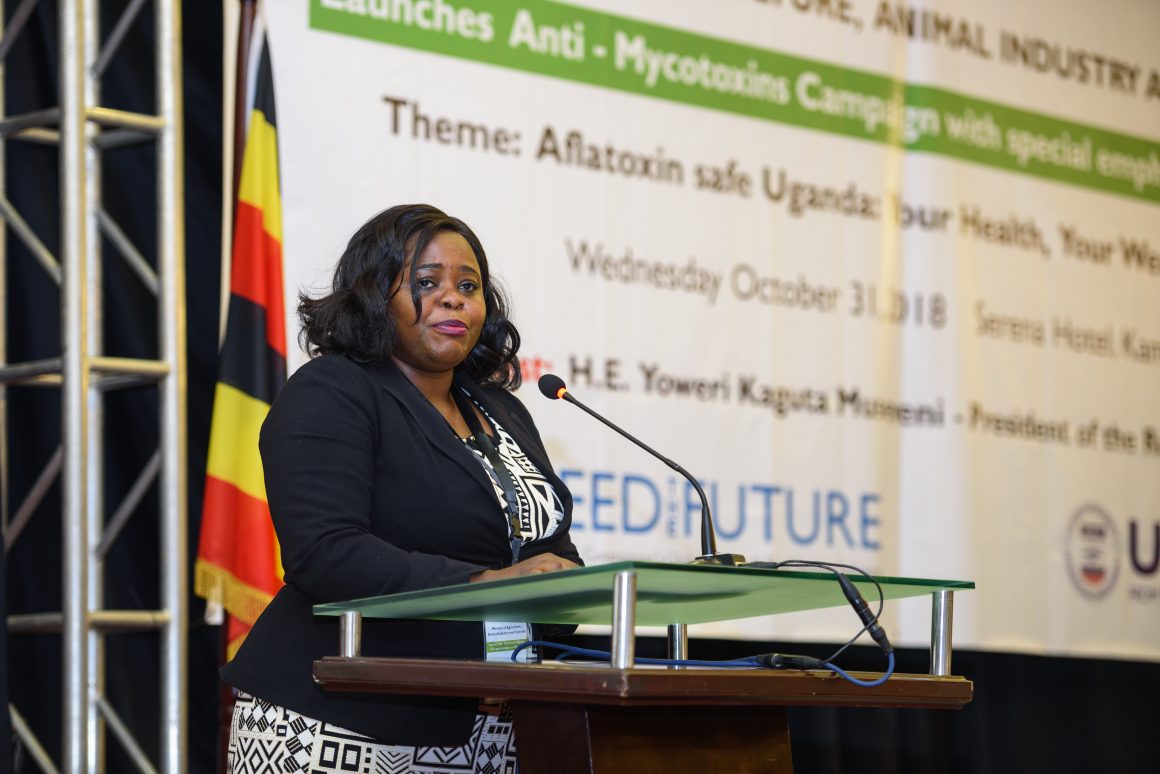
Above: The representative of the African Union Commission Partnership for Aflatoxin Control in Africa (AUC PACA) Wezi Chunga Sambo who delivered the message on behalf of the Commission, noting that Uganda has maintained remarkable progress in achieving targets of the Malabo Declaration on the Comprehensive Africa Agriculture Development Programme (CAADP).
According to the AUC PACA representative, the list of pilot countries has since grown to six and includes Uganda, Malawi, Nigeria, Tanzania, The Gambia and Senegal as countries where technical support is being stepped up by the African Union.
With this inclusion, the Ministry of Agriculture, Animal Industry and Fisheries set up a focal desk in the Directorate of Crop Resources under the division of Food and Nutrition Security that has since engaged in joint activities with the Uganda Mycotoxins Mitigation Steering Committee.
In October 2016, Uganda was again selected as host of the 2nd Partnership Platform Meeting of the African Union Partnership for Aflatoxin Control in Africa.
This meeting convened representatives of member states of the African Union and was opened by His Excellency the President in Entebbe on the 13th of October 2016.
At this meeting, Hon. Vincent Bamulangaki Sempijja the Agriculture Minister presented Uganda’s commitment to supporting the fight against aflatoxins through enhancing research, supporting promotion of appropriate technologies and sensitisation through strategic communication and extension services.
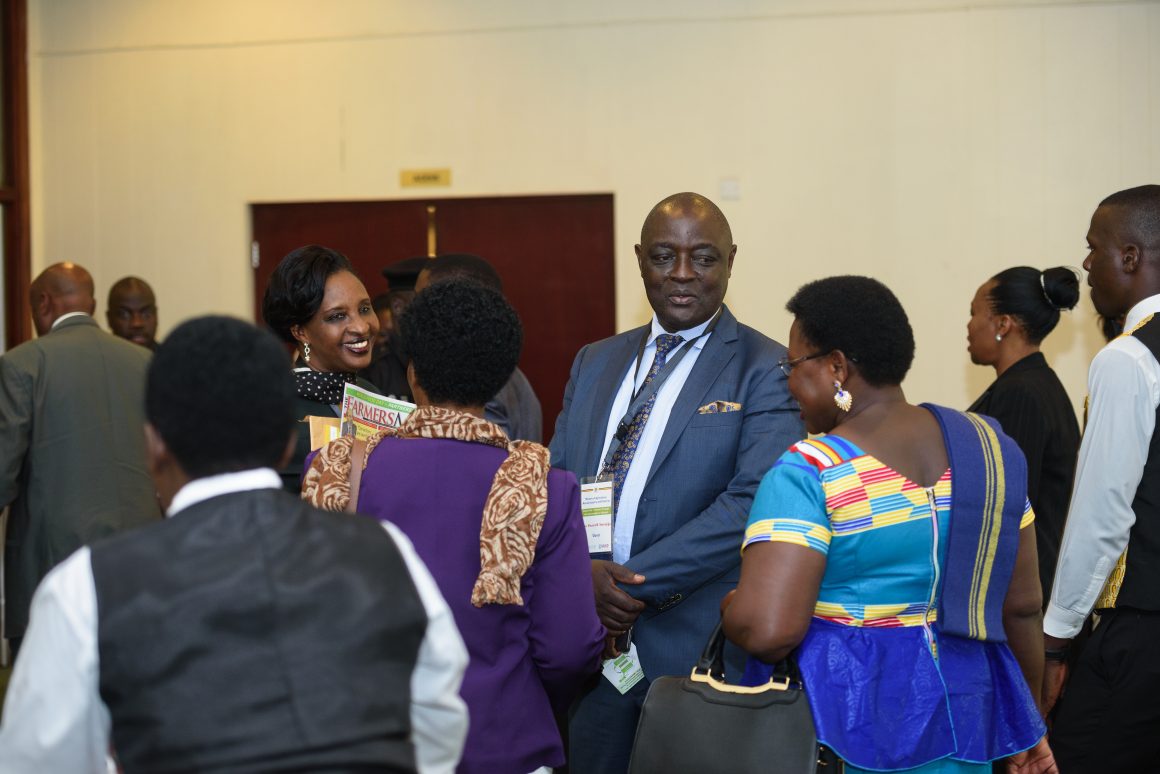
Above: Hon. Vincent Sempijja the Minister for Agriculture, Animal Industry and Fisheries interacting with guests at the launch of the action plan in Kampala.
To date, the Ministry has continued to provide technical and financial support to the Mycotoxins Mitigation Steering Committee and also integrated aflatoxin prevention and control initiatives in key projects which include the Agriculture Cluster Development Project for development of coffee, rice, maize, cassava and bean value chains targeted towards national food security improvement and regional trade and the Uganda Multi-Sectoral Food Security and Nutrition Project.
In addition to that, the Ministry rolled out guidelines aimed at advising farmers across the country to adopt best practices of handling grains.
At the 3rd Partnership Platform Meeting of the AUC-PACA, Prof. Archileo Kaaya from Uganda was also recognised with an award from the African Union as the leading researcher in the field of Aflatoxin Control, indicating Uganda’s progress in research.
In addition to that, the launch of a National Action Plan and Awareness Campaign in line with the African Union’s call for country-led approaches to fighting aflatoxins, made at the partnership meeting in Dakar, Senegal.
Supportive interventions by the USAID Feed the Future Uganda Enabling Environment for Agriculture Activity (EEA)
To increase competitiveness of Uganda’s grain industry, in 2013, EEA embarked on implementation of EAC Maize Grain Standard and EAC Dry Beans Standard by developing IEC materials in simple English version augmented by innovative illustrations and high-resolution pictures. As part of the parameter requirements, the standard outlines acceptable levels of aflatoxins levels in humans. EEA supported several dissemination events such as trainings, awareness sessions etc. EEA supported translation of the IEC materials into six commonly spoken languages of Uganda, namely, Luganda, Swahili, Runyakitara, Atso, Luo and Lugbara.
Support to Maize Quality Control Ordinances
To strengthen standards requirements compliance, EEA further supported selected districts to enact ordinances to combat bad practices that make maize unsafe for human and animal consumption. EEA supported Mubende and Kiboga to enact and launch their ordinances October 2017. Currently, EEA is supporting districts of Kyegegwa, Kakumiro, Mityana, Kibaale, Oyam to develop similar ordinances to increase the geographical area of districts enforcing ordinances.
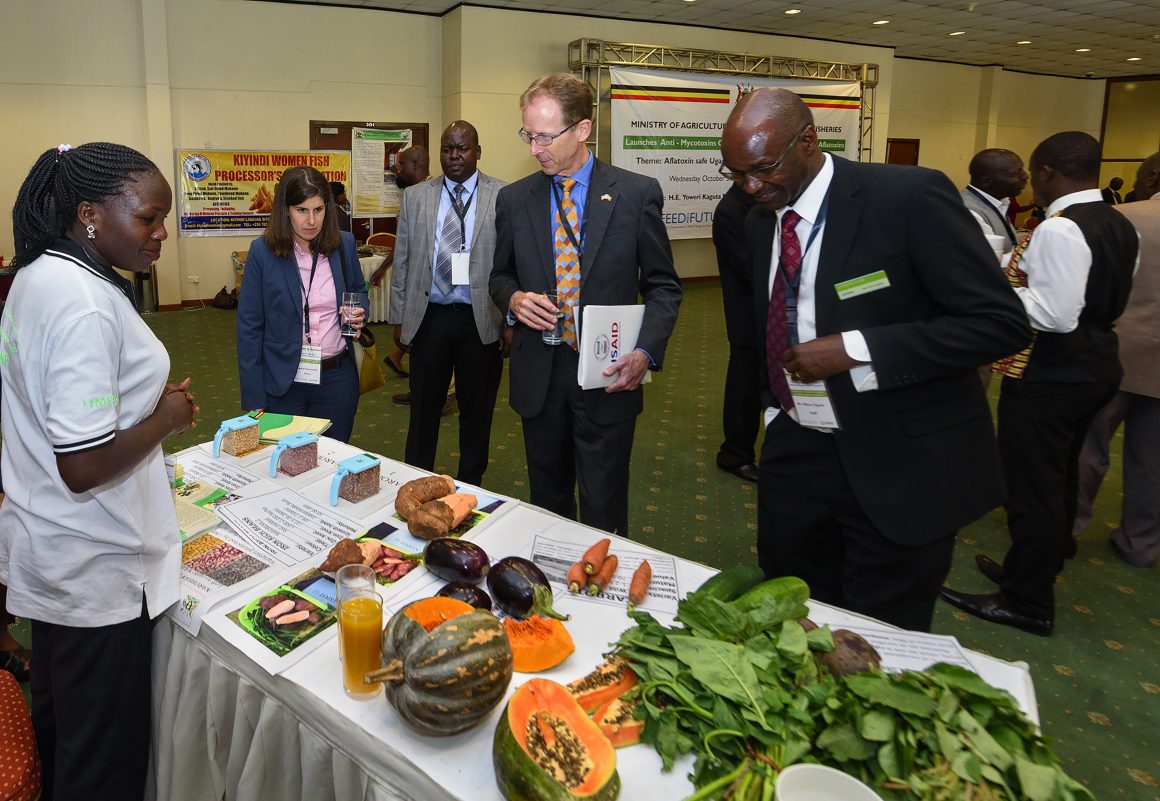
Above: USAID Mission Director Joakim Parker (2nd right) touring the stalls of the Uganda Multi-Sectoral Food Security and Nutrition Project with EEA Country Director Milton Ogeda (right) on the day of the launch. The Uganda Multi-Sectoral Food Security and Nutrition Project promotes best practices of ensuring food and nutrition security across the country.
Support for Aflatoxin Mitigation and Control
In February 2018, at the request of MAAIF, EEA supported DAES to develop easy to understand IEC materials on aflatoxins. EEA supported Technical Working Group meetings, a validation meeting in addition to hiring a graphics designer and a consultant, Prof Kaaya to assist in the development of the IEC materials. EEA is supported the launch of an anti-Mycotoxins Campaign.
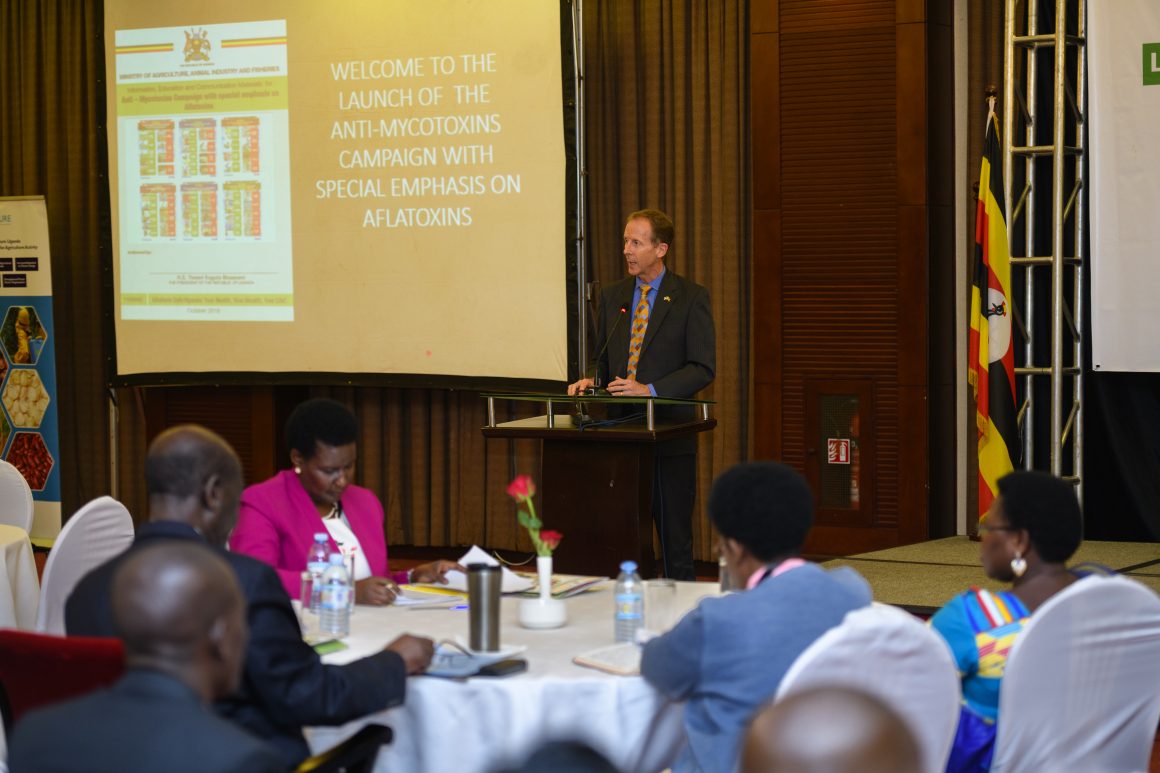
Above: USAID Mission Director Joakim Parker addressing participants at the launch in Kampala.
Support for legal and regulatory framework
EEA has supported MTIC to develop a National Grain Trade Policy and its operationalizing instrument the National Grain Trade Policy Implementation Strategy which have all been launched to date.
EEA further supported the Uganda Warehouse Receipt system Authority to develop a Warehousing and Warehouse Standard, which is a corner stone for warehouse licensing in Uganda and promotes formal trading through the Commodity exchange.
Post-Launch Support Activities
After the launch of the Campaign, EEA plans to support translation of the existing Aflatoxins awareness IEC Materials into about six commonly spoken languages in Uganda and subsequent dissemination.
EEA will also support enactment of the Agricultural Produce Bill which will go along way in prescribing penalties for any persons who contravenes sections of the law relating to marketing of agricultural produce and support developiment of a detailed trainer’s manual as a tool for Uganda’s extension system under DAES, and other Directorates at MAAIF such as Fish and Animals.
In addition to that, EEA will support capacity strengthening of value chain actors through training and sensitization events and support private sector stakeholders through support to forums aimed increasing awareness on the dangers and solutions to combating afaltoxins.
Notes for editors
Below are additional details for editors.
About the Ministry of Agriculture, Animal Industry and Fisheries (MAAIF)
The Ministry of Agriculture, Animal Industry and Fisheries is a Ministry in the Government of Uganda charged with creating an enabling environment in the Agricultural Sector.
The Ministry formulates, reviews and implement national policies, plans, strategies, regulations and standards and enforce laws, regulations and standards along the value chain of crops, livestock and fisheries.
Vision: A competitive, profitable and sustainable agricultural sector.
Mission: To transform subsistence farming to commercial agriculture.
See strategic objectives here.
See Agriculture Sector Strategic Plan here.
The Ministry of Agriculture, Animal Industry and Fisheries (MAAIF) is made up of four Directorates including the Directorate of Crop Resources, Directorate of Animal Resources, Directorate of Agricultural Extension Services and the Directorate of Fisheries Resources each with Departments, Divisions and Partnership Projects.
The Departments of the Ministry which do not fall directly in the above include the Department of Agricultural Planning and Development, the Human Resource Department, the Department of Finance and Administration and the Department of Agricultural Infrastructure, Mechanisation and Water for Agricultural Production.
The Ministry is also made up of seven Agencies including the National Agricultural Research Organisation (NARO), the National Agricultural Advisory Services (NAADS), Cotton Development Organisation (CDO), Dairy Development Authority (DDA), Uganda Coffee Development Authority (UCDA) and Coordinating Office for the Control of Trypanosomiasis in Uganda (COCTU) and the National Animal Genetic Resources Centre and Databank (NAGRC&DB).
About the African Union Commission Partnership for Aflatoxin Control in Africa (AUC PACA)
PACA’s Mission: To support agricultural development, safeguard consumer health and facilitate trade by catalyzing, coordinating and increasing effective aflatoxin control along agricultural value chains in Africa.
PACA’s Role: To provide leadership and coordination for Africa’s aflatoxin control efforts, acting primarily as catalyst, facilitator, partnership and knowledge broker, project developer and information clearinghouse. PACA will also advocate for the establishment of enabling policies and institutions, increased investment and the mobilization of resources, and should ultimately act as a grant-maker to support priority aflatoxin control activities.
PACA’s Strategic Thematic Areas of Work The following thematic areas have been identified as the focus of work for PACA for the next ten years: 1. Research and technology for the prevention and control of aflatoxins 2. Policies, legislation and standards for the management of aflatoxins 3. Growing commerce and trade and protecting human health from aflatoxins 4. Enhancing capacity for effective aflatoxin prevention and control 5. Public awareness, advocacy and communication
